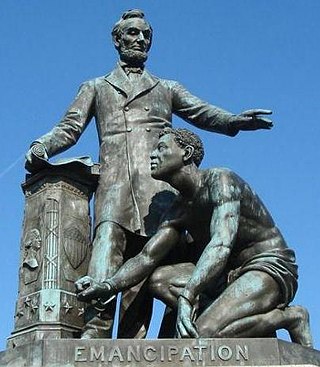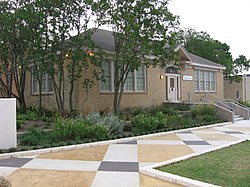
The Emancipation Proclamation, officially Proclamation 95, was a presidential proclamation and executive order issued by United States President Abraham Lincoln on January 1, 1863, during the American Civil War. The Proclamation had the effect of changing the legal status of more than 3.5 million enslaved African Americans in the secessionist Confederate states from enslaved to free. As soon as slaves escaped the control of their enslavers, either by fleeing to Union lines or through the advance of federal troops, they were permanently free. In addition, the Proclamation allowed for former slaves to "be received into the armed service of the United States". The Emancipation Proclamation played a significant part in the end of slavery in the United States.

Juneteenth is a federal holiday in the United States commemorating the end of slavery. Its name is a portmanteau of "June" and "nineteenth", as it is celebrated on the anniversary of June 19, 1865, when as the American Civil War was ending, Major General Gordon Granger ordered the final enforcement of the Emancipation Proclamation in Texas. Originating in Galveston, Juneteenth has since been observed annually in various parts of the United States, often broadly celebrating African-American culture.

Emancipation Day is observed in many former European colonies in the Caribbean and areas of the United States on various dates to commemorate the emancipation of slaves of African descent.

The history of slavery in Texas began slowly at first during the first few phases in Texas' history. Texas was a colonial territory, then part of Mexico, later Republic in 1836, and U.S. state in 1845. The use of slavery expanded in the mid-nineteenth century as White American settlers, primarily from the Southeastern United States, crossed the Sabine River and brought enslaved people with them. Slavery was present in Spanish America and Mexico prior to the arrival of American settlers, but it was not highly developed, and the Spanish did not rely on it for labor during their years in Spanish Texas.

The Southgate–Lewis House is located one mile east of the Texas State Capitol in Austin, Texas, at 1501 East 12th Street. The house was constructed in 1888, and now stands as an African-American historical landmark. It is also a repository for African-American History and Culture in the region of east Austin, which historically became an African-American neighborhood. The City of Austin has now declared this region to be "Austin's Black Cultural District." The Southgate–Lewis House is located in the center of the "African American Cultural Heritage District".

The Emancipation Memorial, also known as the Freedman's Memorial or the Emancipation Group is a monument in Lincoln Park in the Capitol Hill neighborhood of Washington, D.C. It was sometimes referred to as the "Lincoln Memorial" before the more prominent so-named memorial was dedicated in 1922.

The Star of the Republic Museum, in Washington, Texas, United States, is the only museum in the state of Texas created specifically to collect and interpret the culture and history of the Republic of Texas from 1836 to 1846. Within the museum's two floors of exhibits, visitors can learn about the history of the time period through media experiences, as well as informative exhibits. The site of the Star of the Republic Museum was selected at Washington on the Brazos where elected delegates gathered on March 2, 1836, to declare Texas’ independence from Mexico.
E Pluribus Unum is a public artwork proposed by American artist Fred Wilson to be located along the Indianapolis Cultural Trail at the northeast corner of Delaware and Washington streets, near the City-County Building in downtown Indianapolis, Indiana, United States.

Reedy Chapel A.M.E. Church is a historic African Methodist Episcopal (A.M.E.) church located at 2013 Broadway in Galveston, Texas. The church's congregation was founded in 1848 by enslaved African Americans and, following emancipation in 1865, the church was organized as Texas's first A.M.E. congregation in 1866. Reedy Chapel A.M.E. Church was one of locations of the public reading of General Order No. 3 by Union general Gordon Granger on June 19, 1865 which officially declared emancipation in Texas. The annual celebration of this declaration among African Americans continues today as the Juneteenth holiday.

Ashton Villa is a fully restored, historic home located on the corner of 24th and Broadway in Galveston, Texas, United States. Constructed in 1859, it was one of the first brick structures in Texas built by slaves.

The history of African Americans in Austin dates back to 1839, when the first African American, Mahala Murchison, arrived. By the 1860s, several communities were established by freedmen that later became incorporated into the city proper. The relative share of Austin's African-American population has steadily declined since its peak in the late 20th century.

The African American population in San Antonio, Texas has been a significant part of the city's community since its founding. African Americans have been a part of the Greater San Antonio's history since the late 1800s. San Antonio ranks as the top Texas destination city for Black professionals.

General Order No. 3 was an American legal decree issued in 1865 enforcing the Emancipation Proclamation to the residents of the U.S. state of Texas and freeing all remaining slaves in the state. The general order was issued by Union General Gordon Granger on June 19, 1865, upon arriving at Galveston, Texas, at the end of the American Civil War and two and a half years after the original issuance of the Emancipation Proclamation. The order, and Granger's enforcement of it, is the central event commemorated by the holiday of Juneteenth, which originally celebrated the end of slavery in Texas.

Newton Isaac Collins Sr. was an African-American freedman from Alabama who moved to Travis County, Texas, in the 1840s, where he was re-enslaved. After the Emancipation Proclamation, Collins again received his freedom and became a businessman, land owner, and community leader in southeastern Travis County.

The Emancipation Memorial, also known as the Freedman's Memorial or the Emancipation Group was a monument in Park Square in Boston. Designed and sculpted by Thomas Ball and erected in 1879, its sister statue is located in Lincoln Park in the Capitol Hill neighborhood of Washington, D.C. The Boston statue was taken down by the City of Boston on December 29, 2020, following a unanimous vote from the Boston Art Commission on June 30 to remove the memorial.

The history of slavery in Colorado began centuries before Colorado achieved statehood when Spanish colonists of Santa Fe de Nuevo México (1598–1848) enslaved Native Americans, called Genízaros. Southern Colorado was part of the Spanish territory until 1848. Comanche and Utes raided villages of other indigenous people and enslaved them.

The Juneteenth flag is a symbol for the Juneteenth holiday in the United States. The first version was created in 1997 by activist Ben Haith and that early version was displayed in 1997. The present version was first flown in 2000. The colors and symbols on the flag are representative of freedom and the end of slavery. The date on the flag represents that of General Order No. 3 issued in Galveston, Texas in 1865. Beginning in 2020, many states began recognizing Juneteenth by flying the flag over their state capitol buildings, especially after Juneteenth was declared a federal holiday by President Joe Biden the following year.

From the late-18th to the mid-19th century, various states of the United States of America allowed the enslavement of human beings, most of whom had been transported from Africa during the Atlantic slave trade or were their descendants. The institution of slavery was established in North America in the 16th century under Spanish colonization, British colonization, French colonization, and Dutch colonization.
Andrea R. Roberts is an American educator, researcher, college professor, guest speaker, and planning historian, who is an associate professor in the Department of Urban and Environmental Planning for cultural planning at the University of Virginia. Her research centers around intentional communities built by Black people. She is Co-director Center for Cultural Landscapes at the University of Virginia. She founded The Texas Freedom Colonies Project in 2014. Her work centers around unrecorded histories and endangered historic black settlements, towns known also as freedom colonies founded in 1866–1930. Roberts is a 6th generation Texan. Her ancestors were enslaved Africans that founded freedom colonies.

















